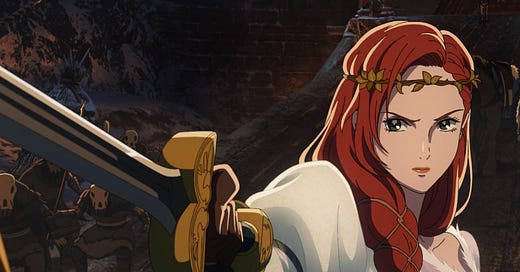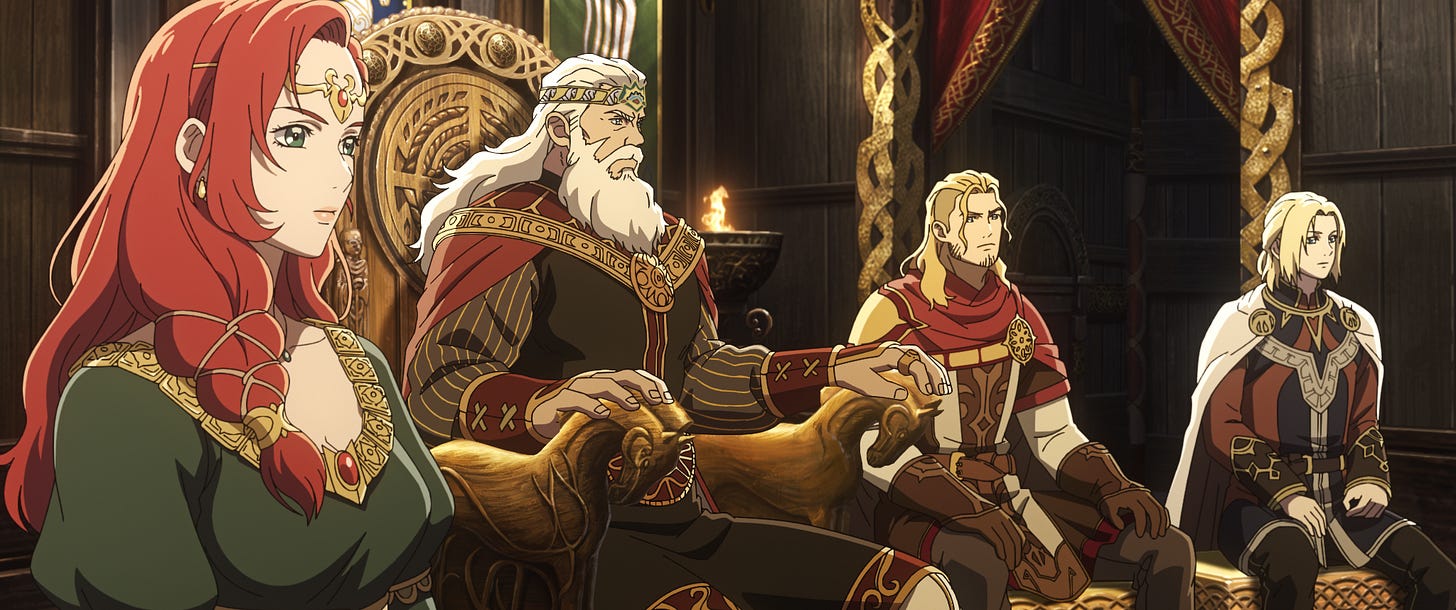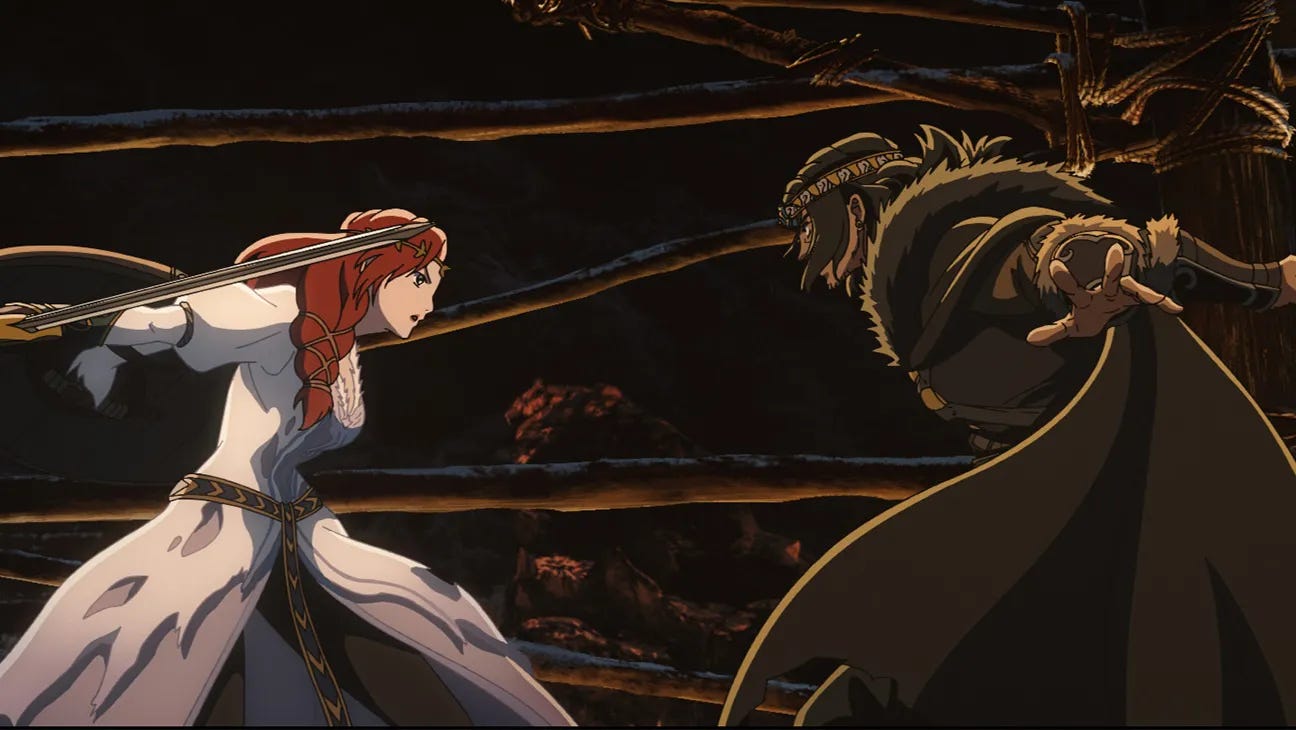Welcome to the Word-Hoard. It has been more than half a year since my last post, but very soon I will begin to regularly post again as I focus on a key figure of medieval literature. Before that, however, I wanted to make a comeback with a brief look into more Lord of the Rings content, featuring the newest feature film: The Lord of the Rings: The War of the Rohirrim.
The War of the Rohirrim is an anime film directed by Kenji Kamiyama and produced by Peter Jackson. I recently watched the movie in theaters when it was released in December of last year, and for a while I’ve debated whether or not I wanted to write a review of it. Before I give my own opinion of the movie, I wanted to give some context of what other people are saying about it - this movie turned out to be way more controversial than I would’ve imagined back when I first heard it announced. On a cursory glance, if we Google the movie, we can see that IMDb gives it a 6.4/10, Rotten Tomatoes rated it at 47%, and Fandango at 82%. None of these seem to be particularly glowing or horrible, but it strikes me as a large margin between those three numbers. If we dive deeper into the critic and audience reviews, we can see that they vary greatly, from loving the movie and thinking it was incredible, to hating it and thinking it was terrible. From what I read, most critics appear to be of the mind that while The War of the Rohirrim may have some good moments, the film does not hold up under close inspection, ultimately giving it mediocre or below-average reviews.
I wish to challenge this notion. I was getting mixed signals about The War of the Rohirrim even before I saw it, but I was looking forward to seeing it on the big screen, and went into the theater cautiously optimistic. I left thoroughly entertained, and I feel that it was an injustice that the film bombed at the box office when there are many things to appreciate about it. For the rest of this post, I will briefly comment on the animation before moving on to the narrative and how it compares to Tolkien’s source material.
Like many other aspects of the movie, the animation seemed to be hit or miss for viewers; some praised it while others condemned it. The War of the Rohirrim uses a style that mixes 2D elements - most moving things like the characters and animals - with 3D backgrounds and environments. One animator claimed that it was difficult to watch parts of the movie because there were moments where the 2D and 3D elements did not seamlessly blend together, resulting in some animation mistakes and making the film feel rushed. I am no animator, and perhaps if I had the same trained, artistic eye I would have caught this, but in my viewing I didn’t notice anything out of place, nor have I seen many similar comments from general audiences. Personally, I was a fan of both the animation and art style, and as a fan of Japanese animation, I found the choice to use it for a story set in Middle-Earth an interesting but welcome one. The movements during scenes such as horses charging or sword fights between characters seemed very impressive. One visual element I particularly enjoyed was the character designs, which all boldly stand out from one another to make characters recognizable, and while the anime style may not be the best method if you’re trying to depict Tolkien’s characters and peoples with 100% accuracy, it is at worst an admissible artistic decision, and for me, no issue at all since I think the designs were effective.
I now move on to the plot, so with that in mind, spoilers ahead for War of the Rohirrim as well as other Lord of the Rings media. At first, I thought this movie might feature an original story, but I soon realized that the plot is actually based on the story of Helm Hammerhand which can be found in the appendices of The Lord of the Rings, under Appendix A: Annals of the Kings and Rulers, Part II: The House of Eorl. Upon rereading the few paragraphs were Helm is featured, I was impressed by how accurate the film was to the source material.
In summary: There was a rich and powerful man named Freca, who was rumored to have much Dunlending blood, who often did not come to the King of Rohan’s councils. Once when Helm summoned Freca, Freca rode with many men to ask for the hand of Helm’s (unnamed) daughter for his son Wulf. Helm and Freca trade insults, then go outside to fight, which results in Helm striking Freca with such a mighty blow that he falls down stunned and soon dies. Wulf is banished, but a few years later he leads a force of Dunlendings and enemies of Gondor against Rohan, resulting in the death of Helm’s eldest son Haleth as he defends the doors of Meduseld and Wulf usurping the throne. Helm and his younger son Háma are forced to take refuge with his people in his fortress the Hornburg (later renamed Helm’s Deep) during the Long Winter. Háma leaves to try and find food, but never returns. In his grief and rage, Helm would go out alone among the Dunlending ranks, stalking his enemies and slaying them with his bare hands (for it was believed if he bore no weapons none could strike him down), until one night he dies, his body found frozen but still standing. Helm’s nephew Fréaláf Hildeson retakes Edoras and slays Wulf, thus becoming the first king of the second line.
This story is very closely followed in The War of the Rohirrim, right down to the detail of Helm calling Freca fat (something along the lines of “I see your stomach has grown with your lands Freca”). I always appreciate when an adaptation is faithful to the original work. There were only two major deviations in this narrative in the movie. The first is that Háma is slain by Wulf instead of being lost in the snow - this was likely changed in order to create a more dramatic scene for the film. The second is that Wulf was not killed by Fréaláf, but by Hèra. Who is Hèra? In the film, she is Helm’s unnamed daughter, and the protagonist.
There has been some hate around the fact that Hèra is the lead. I think some of this may have come from worry that she would be another Galadriel from The Rings of Power series, a female lead that is unlike the female characters Tolkien wrote, and as a result doesn’t quite fit in the world of Middle-Earth. When I get into Hèra’s characterization, I hope I can convince you that this is not the case, and instead Hèra is a strong female character who also aligns with Tolkien’s aesthetic. Another concern might have been that she doesn’t belong in this story because she’s not in the books, similar to complaints about the character of Tauriel from Jackson’s The Hobbit film adaptations. The important distinction is that while Tauriel is purely an original movie character, Hèra’s basis as Helm’s unnamed daughter is in Tolkien’s work, and the movie has simply added information in order to expand upon the character in the same way that the movie adds details to expand upon the story featured in the appendices; the name of Hèra may not be canon, but her existence very much is. Yet others have claimed that The War of the Rohirrim should have followed Helm. I say that the story is as much Helm’s as it is Hèra’s, giving him plenty of screen time and developing the father-daughter relationship between the two. Furthermore, the screenwriters of the film have stated that Hèra was selected as the protagonist both to act as the audience surrogate, to follow a more relatable character rather than Helm, a mighty king who often acts as the driver of the plot, and because she is only member of the royal family besides Fréaláf who survives, which is in Tolkien’s canon.
Hèra is clearly an Éowyn figure as a shieldmaiden of Rohan. (By the way, Miranda Otto reprises her role as Éowyn as the narrator of the film.) I already cover the role of Éowyn’s character and her symbolism in my substack “I Will Smite You If You Touch Him,” so I highly recommend checking that out if you’re interested in more information, but basically, Éowyn represents a feminine, or defensive/protective strength, rather than a masculine, or attacking/outreaching strength. Hèra’s actions prove that she exhibits the same form of strength. The first example comes from her encounter with the oliphaunt - first she distracts the beast and forces it to chase her to get it away from her allies to get them out of harms way. Then, knowing she isn’t strong enough to bring down the animal on her own, she instead uses her wit to defeat the beast by leading it to the lair of a larger creature. The second example comes from her final battle with Wulf, whom The War of the Rohirrim portrays as someone who used to be her friend when they were children and who truly loved her before he is blinded by hatred for Helm. I will refrain from breaking down every move of their fight, but essentially, the sword fight shows that Hèra is clearly a capable warrior, though still far less strong and skilled than Wulf. When it appears that Wulf will soon win, Hèra is forced to raise her shield to protect herself from Wulf’s furious blows. After a few strikes, Wulf’s sword becomes buried in the wood of her shield and momentarily becomes stuck. Hèra seizes this opportunity and tosses her shield aside, taking Wulf’s sword with it, leaving him disarmed and vulnerable to a killing blow. Like Éowyn defending Théoden from the witch king, the shieldmaidens’ role is defenders of Rohan, and it is Hèra’s shield, not her sword, which wins the day.
It was because of The War of the Rohirrim’s faithfulness not only to Tolkien’s history, but also the essence of Tolkien’s characters and narrative that I think the movie was well written. I believe it is a worthy inclusion in the collection of Lord of the Rings media, and I would highly encourage anyone interested to see the film yourself and form your own opinion on it if you’re a Lord of the Rings fan, or even if you’re looking for a good fantasy.
Next time I begin my journey for the first time into the works of Chaucer, but until then, thanks for reading.







